How to visit the Coba Ruins & nearby Cenotes
The Coba Ruins are the remains of a Mayan City located in the jungle of the Yucatan Peninsula. They are located close enough to Tulum and Playa Del Carmen for a day trip. But the great thing is that they are nowhere near as crowded as other ruins such as Chitzen Itza and the Tulum ruins.
One thing that is interesting about Coba is that there are many ruins buried under trees. Today the crumbling remains of the city are scattered throughout the jungle. They cover such a large area that the best way to explore the ruins is to hire a bike which makes it a really unique experience compared to other ruins.

Part 1: Visiting the Coba Ruins
Let’s dive right into everything you need to know before visiting the Coba Ruins.
Can You Still Climb The Pyramid At Coba? 🥾
It used to be possible to climb up the main pyramid which I did on my first visit in 2019. But since 2020 it is not possible anymore to climb up the Coba Ruins due to Covid.
There is a high chance they won’t be able to climb again due to preservation efforts which were already discussed before Covid hit. Covid was just the tipping point for taking away the option of climbing the pyramid.
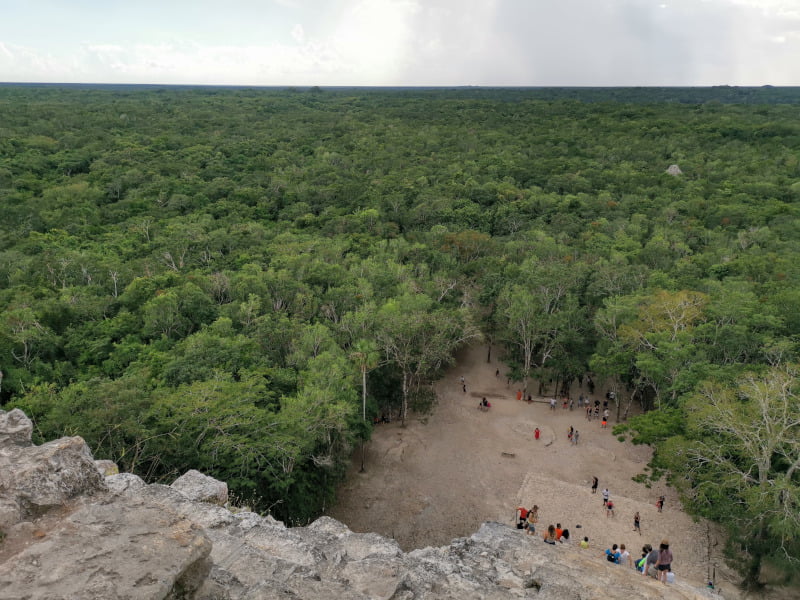
When I was visiting the ruins end of 2022 again I thought it might be less of a great experience without the climb but for sure it was not! Coba is still one of my favorite Mayan ruins to visit in the Yucatan and I highly recommend visiting them.
So keep reading to find out what to expect on your trip to the Coba Ruins in 2023.
Coba Ruins Location 📍
The Coba Ruins are located in the small town of Coba and are only a 45-minute drive from Tulum and a 1.5-hour drive from Playa del Carmen. So if you are staying in either of those places they make the perfect day trip.
There are also several really cool cenotes located nearby which are great places to cool down after exploring the ruins and I will cover them later on in this guide.

How To Get To The Coba Ruins
The three options you have to arrive at Coba are by bus, colectivo, or rental car. The Coba Ruins are easy to reach from Playa del Carmen and Tulum.
By Bus 🚍
To arrive by bus there are two companies that you can choose from.
ADO is the fancier bus line and they depart once a day daily from Play Del Carmen at 8:40 am arriving at the ruins at 10:30 am. The ticket price is 175 pesos (8 USD) one-way. The ADO bus also stops in Tulum and departs at 9:45 am arriving at 10:30 am at the ruins for 100 pesos (5 USD) one-way.
The ADO bus returns once a day daily from Coba at 3:30 pm to both Tulum and Playa Del Carmen. It will arrive in Tulum at 4:45 pm and in Playa del Carmen at 5:30 pm. When we went to Coba with ADO we traveled in a van which was very comfortable. But it may be that in the busier season, they will have a full-sized bus.
You can buy your tickets at the ADO bus station, via the ADO website or the ADO app. I recommend having the app as it is the most convenient and fast.

By Colectivo 🚐
Colectivos depart from Tulum to the Coba Ruins and are the cheapest option. You will however have to be a bit more flexible to catch them as they will only leave when full. You could arrive a bit earlier and depart a bit later from Coba than the ADO, but since they don’t run on a schedule you won’t know in advance. Because the price is the same as the ADO van I recommend choosing ADO.
The last regular colectivo departs from Coba to Tulum at 4:00 pm and costs 100 pesos (5 USD) each way. From there you could get into another colectivo or bus to Playa del Carmen or even Cancun.
Outside the main colectivo station in Playa Del Carmen we saw shared taxis for 200 pesos (10 USD) per person. So if you are in a group of 4 or are willing to share with strangers this might be a good option. The advantage of this is that it should be faster than a colectivo or bus and that you could leave earlier.
Renting A Car 🚗
Renting a car can also be very affordable particularly if you are in a group. A car is a great option because you have much more flexibility when you arrive and depart. The ruins open at 8 am and most people will arrive after 10:30 am so if you arrive early you should have the site mostly to yourselves.
There are also some great cenotes located about 6 km from the ruins so if you have a car you can visit these afterward. If you do not have a car you would have to get a taxi, more on that in the second part of this guide.
The first time I visited the Coba Ruins we booked a rental car here which we picked up and returned at Cancun airport and I can highly recommend it. I found it to be the cheapest rental car option in the Yucatan and have used it twice so far.
Coba Opening Hours
The opening hours of Coba are 8 am to 4 pm every day of the week.
Coba Ruins Price 🎟️
The price to enter the Coba archaeological site is 100 pesos (5 USD). You can buy your Coba ruins tickets from the booths next to the entrance.
As I mentioned above the ruins cover a huge area so it is very popular to rent a bike inside.
Bike rental is 65 pesos (3 USD) and you can rent them inside after the first group of ruins. I personally enjoyed cycling around the ruins as it allowed you to see everything much faster. There were many roads built in Coba that spread out for large distances around the Yucatan. The longest of these roads was over 100km long and some of the paths that you will travel on around the site are the original roads built by the Maya.
In my opinion, cycling is the best way to explore the ruins. However, if you enjoy walking you can take your time and you may have a chance to spot some monkeys!
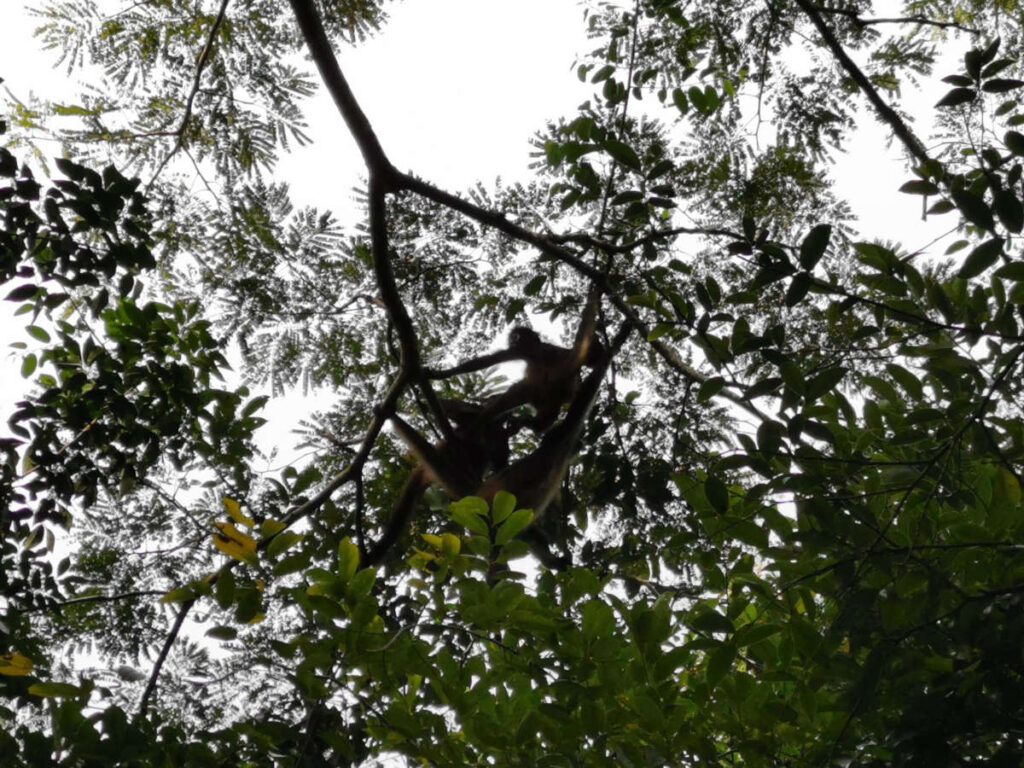
Coba Ruins History 🤓
Let’s have a brief look at Coba Ruins’ mysterious history first to get out the best out of your visit. Coba was a Mayan City with over 50,000 inhabitants at its peak and covered an area of 80 square km. Many people know of the Mayan civilization because of their advanced knowledge of mathematics, astrology and the doomsday predictions in 2012.
The Mayans were the dominant civilization in Southern Mexico and Central America for thousands of years before the arrival of the Spanish. But many people don’t realize that the Mayans never disappeared. The Mayan language is still spoken by 6 million people throughout Mexico and Central America and their culture is very much still alive.
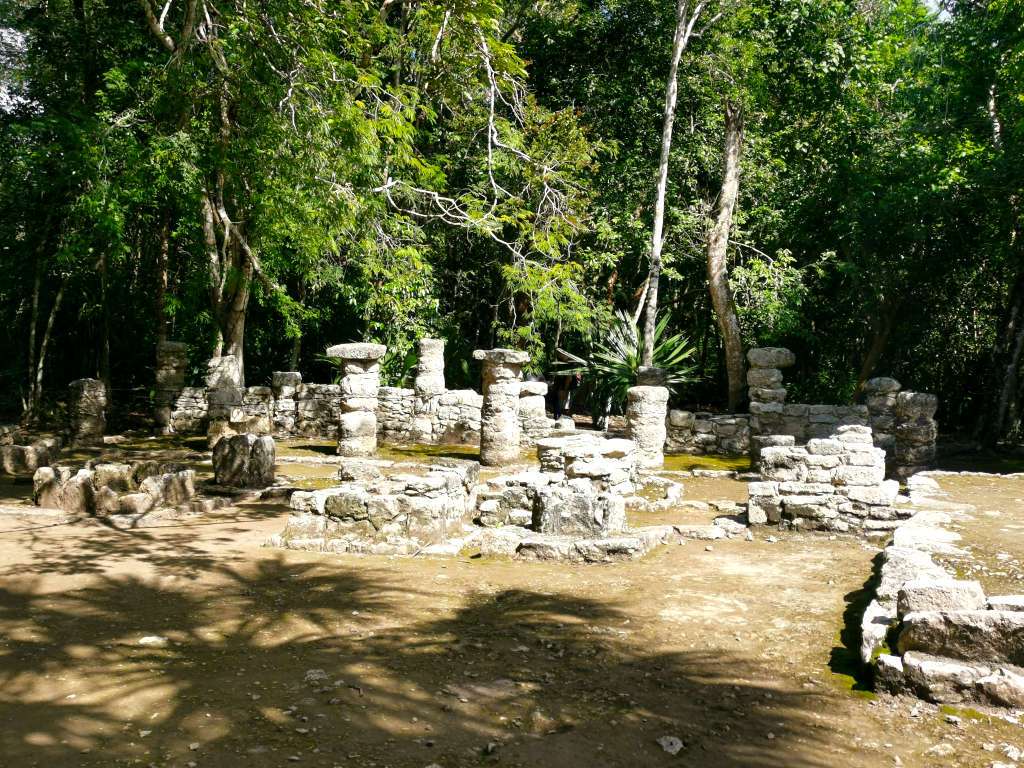
Unfortunately, a lot of their culture was destroyed by the arrival of the Spanish in the 1500s. When the Spanish arrived they destroyed many Mayan books and artifacts so much of their history was lost.
Coba however was already abandoned when the Spanish arrived around 1550. The reason for this is a little mysterious as many huge Mayan cities all throughout Central America were totally abandoned. Some theories are that there was a severe drought combined with deforestation that resulted in the collapse of the cities. But the real reason will most likely never be known, so it all remains a mystery.
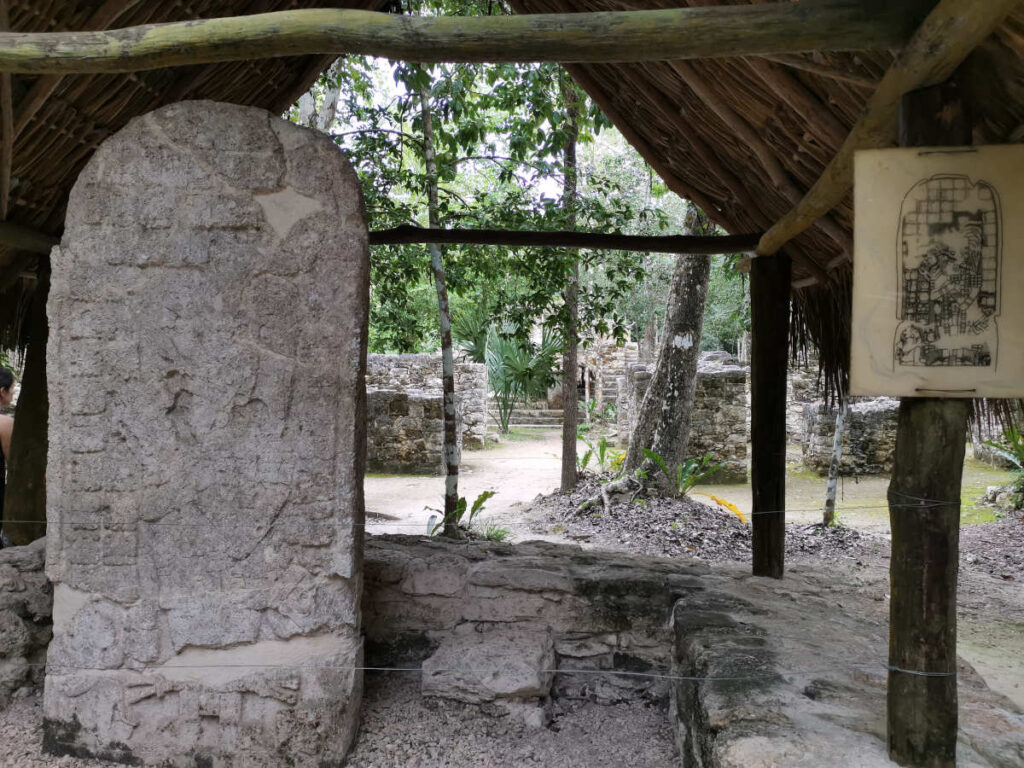
Coba was a dominant city in the area between 200 and 600 AD. After this point, the more famous city of Chichen Itza emerged and there was a power struggle between the two cities. Chichen Itza was the more powerful city and was victorious causing Coba to slowly lose importance.
Over the centuries cities along the coast became more important until Coba was almost totally abandoned. The site remained abandoned in the jungle unknown except to local Maya and archaeologists until the 1970s.
Opening Of Coba For Tourism
During the 1970s with the development of Cancun, it was realized Coba could be opened up to tourists. So a road was built and the site was cleared to allow tourists to visit. However, even though a huge area has been opened up only a small section of the city has actually been excavated by archaeologists. The rest remains buried in the jungle.
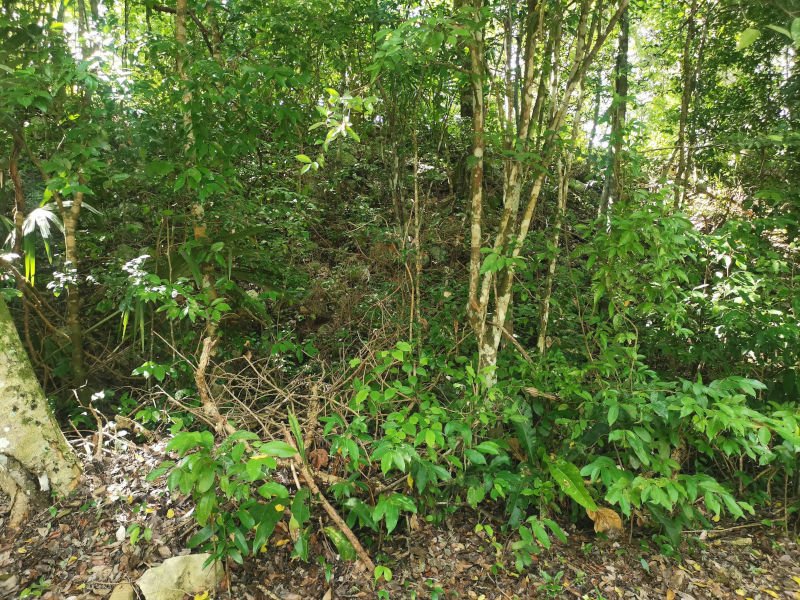
Exploring The Coba Ruins 🤠
Once you enter the ruins you will go up a slight slope where there will be a group of guides waiting for you. A guide told us a tour would be 700 pesos (35 USD) for the group so if you are super interested in the history of the Coba Ruins you can hire a guide here.
At the entrance, if you look to the right you will see a huge mound that looks like a hill but it is actually unexcavated ruins. While you are cycling or walking through Coba if you look into the trees you will see mounds everywhere that are ruins that are yet to be uncovered.
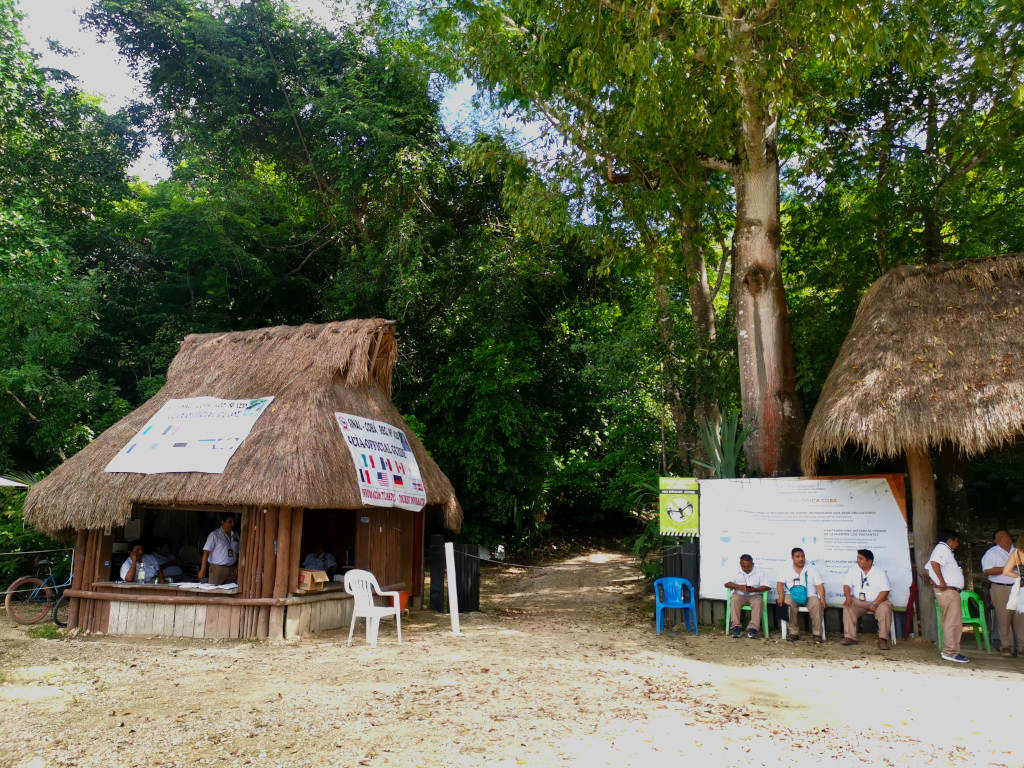
The first group of ruins to explore is called the Church Group and is on the right as you enter. You are not allowed to take bikes in here so you will need to explore these on foot and then rent a bike afterwards.
Near the entrance, there is also a map of the site which is a good idea to have a look at to make sure you know what route to take.
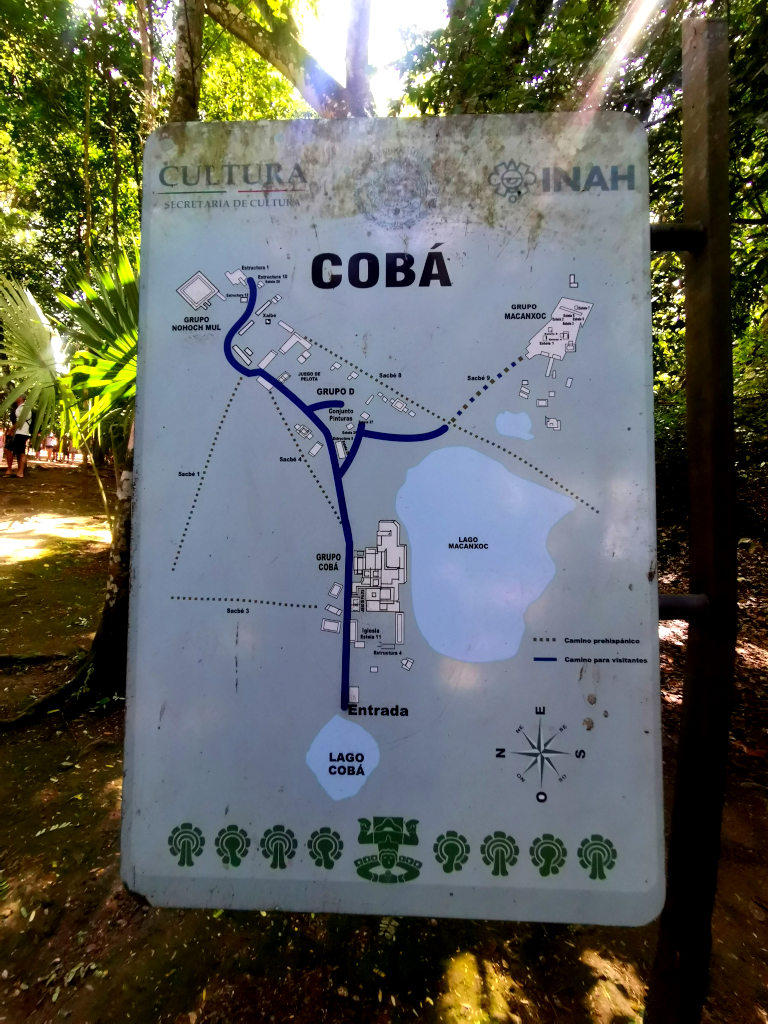
The Church Group ⛪
The Church Group contains the second-largest pyramid in Coba which is also referred to as the church. In this area, there is also a Mayan ball court and several other residential buildings.
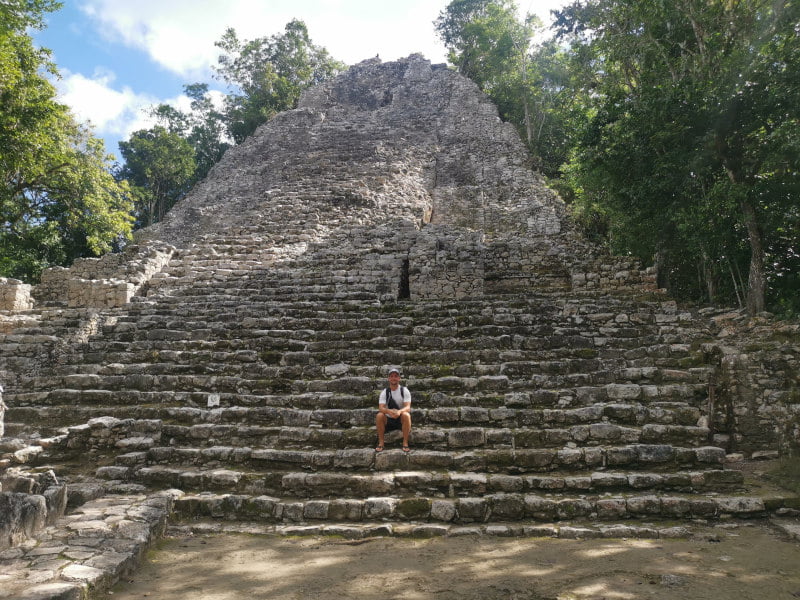
The Ball Court 🏐
The ball court is where a game was played that was popular throughout the Mayan world. In Mexico ruins and all through Central America Mayan ball courts are nearly always found.
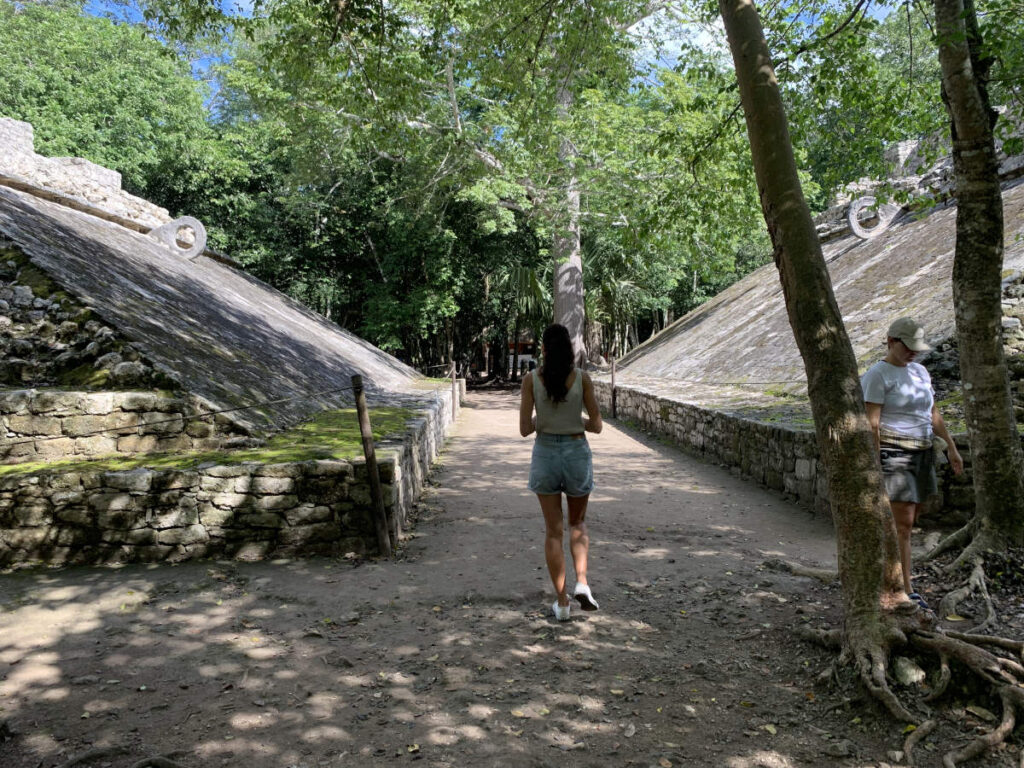
The exact rules of the game are not known but the game was played by bouncing a rubber ball along the walls of the court. One theory is that you could only bounce the ball along the wall with your hips. The aim of the game was to get the ball to the opposing team’s end without it landing in the area between the two walls.
If you got the ball through the hoops it was an instant win for your team. The game seems to have been played for leisure as well as for ritual purposes.
Mayan Fun Facts 🤓
In the Church Group, you will also see a small tunnel that you can walk through. The construction of the tunnel shows an interesting fact about Mayan architecture.
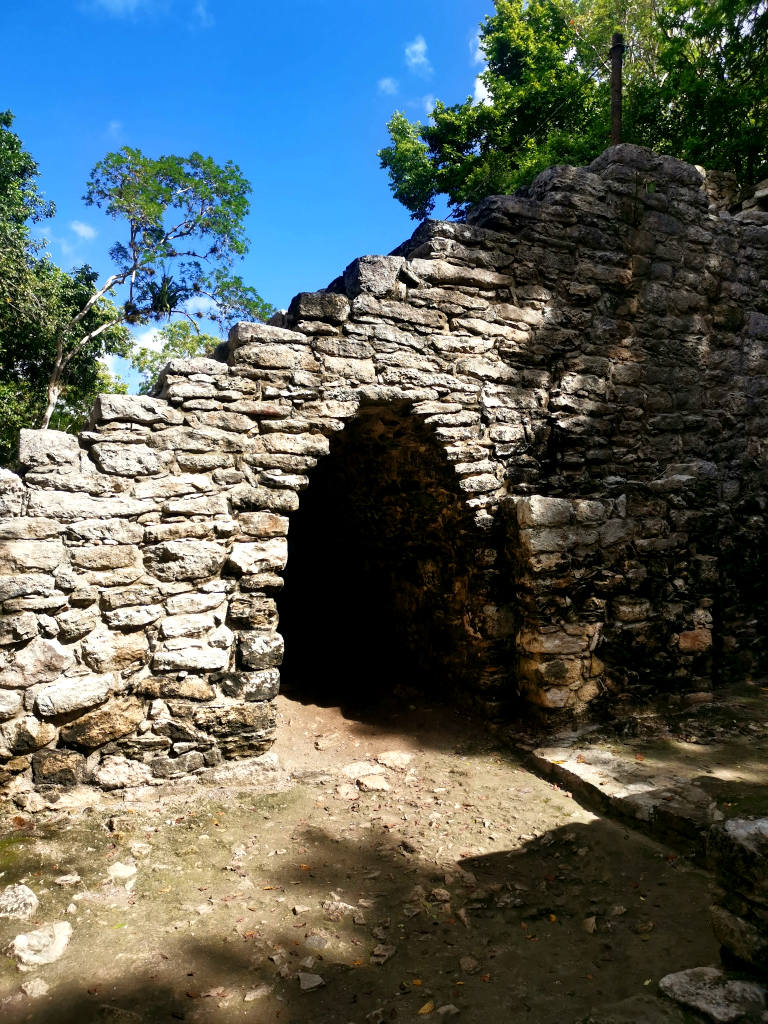
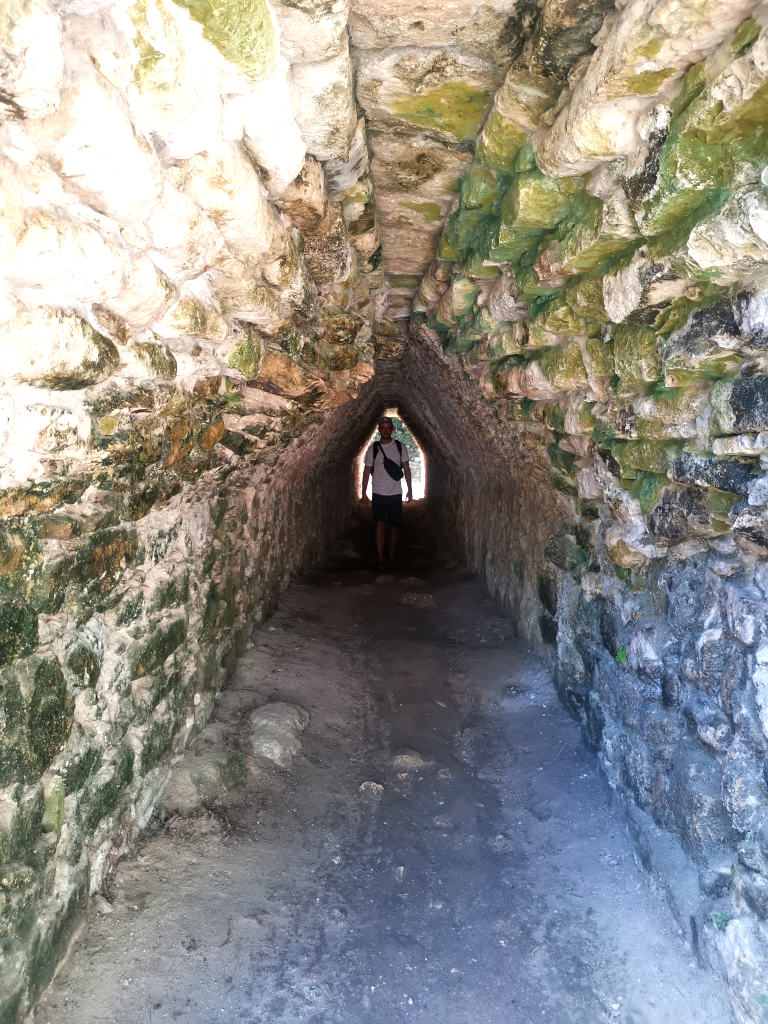
You can see from the pictures that there is no arch in the tunnel. As the Maya never figured out how to construct arches it greatly limited the types of buildings that they could construct.
The Maya also never figured out the wheel so everything was transported using human labour. This is quite strange as they had very advanced knowledge of mathematics and astrology but couldn’t seem to figure out other more basic inventions.
Due to the fact that they had to use human labor to transport materials, it is thought they traveled mainly at night. The roads around the Yucatan were white from limestone so this allowed travelers to easily see where they were going with limited light.
Bike Rental 🚲
After visiting the Church Group you will see the bike rental area. Bikes cost 65 pesos (3 USD) to rent. A lot of the bikes are fairly old but they will get you around the site safely.
If you don’t want to walk and also don’t want to ride a bike you can hire a bike taxi. The bike taxis cost 150 pesos for 2 hours.

Conjunto de Pinturas 🖼️
The Conjunto de Pinturas (‘Set of paintings’) is the next main ruin to visit after the Coba groups. You will arrive at a fork in the road and the pyramid is located in the center of the fork.
The pyramid’s name comes from paintings that were discovered at the top of the temple. Unfortunately, you are not allowed to climb the pyramid but you may be able to catch glimpses if you zoom in from below.
There are also some other buildings and carved stelae in the area to check out. Stelae are stone columns where depictions of Mayan kings were carved into the stone. You will see them throughout Coba and many other Mayan ruins.

Macanxoc Group 🗿
After the Conjunto de Pinturas the next area you should visit is the Macanxoc Group. To get there follow the right-hand side of the fork for a few minutes by bike. It is a really nice ride through the jungle.
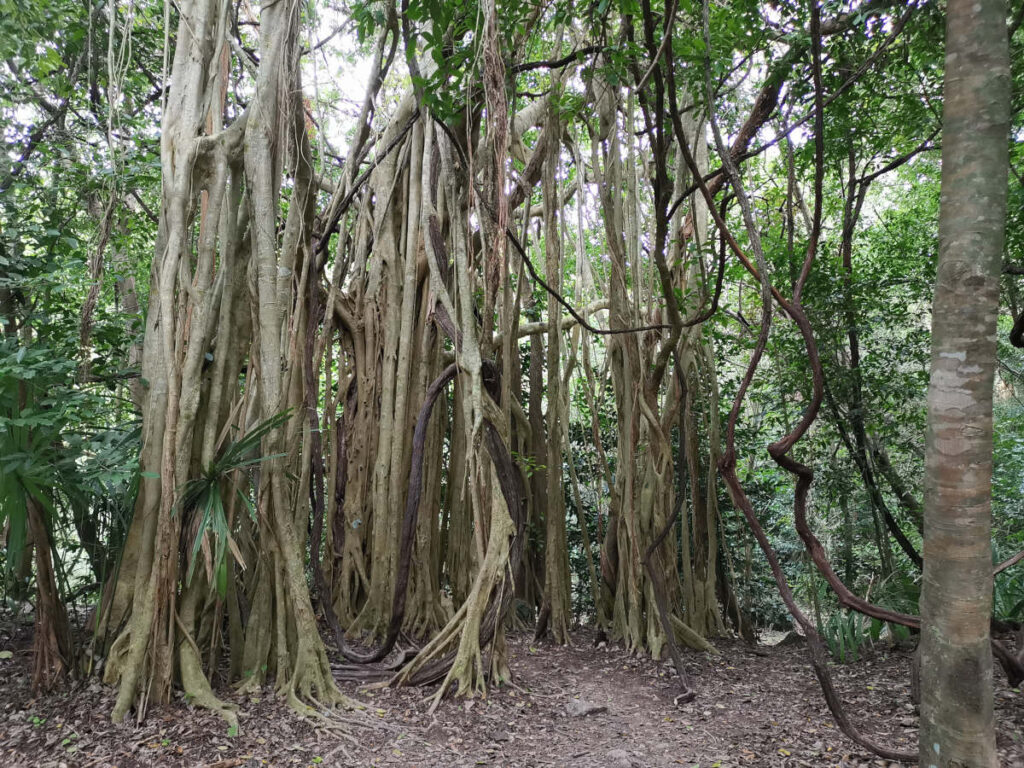
The Macanxoc Group consists of some smaller ruins with a lot of stelaes. Because of the large number of carved stelae it is presumed that this area was of spiritual significance. Unfortunately, because the stelae were carved out of limestone they have been seriously eroded so they are hard to see. However, next to a lot of them there are drawings to help you see what was originally carved.


The Macanxoc Group does not have any large pyramids. But I really liked exploring it as it seems like a lot of people don’t make it up this way. So it was fairly empty when we were looking around.
After the Macanxoc Group, you will have to head back to the fork in the road. At the fork, you will have to take the left-hand side of the fork where you next come to another ball court.
Second Ball Court 🏐
The next ruins that you see along the road is another ball court. This ball court is very similar to the first one but with a couple of interesting differences.
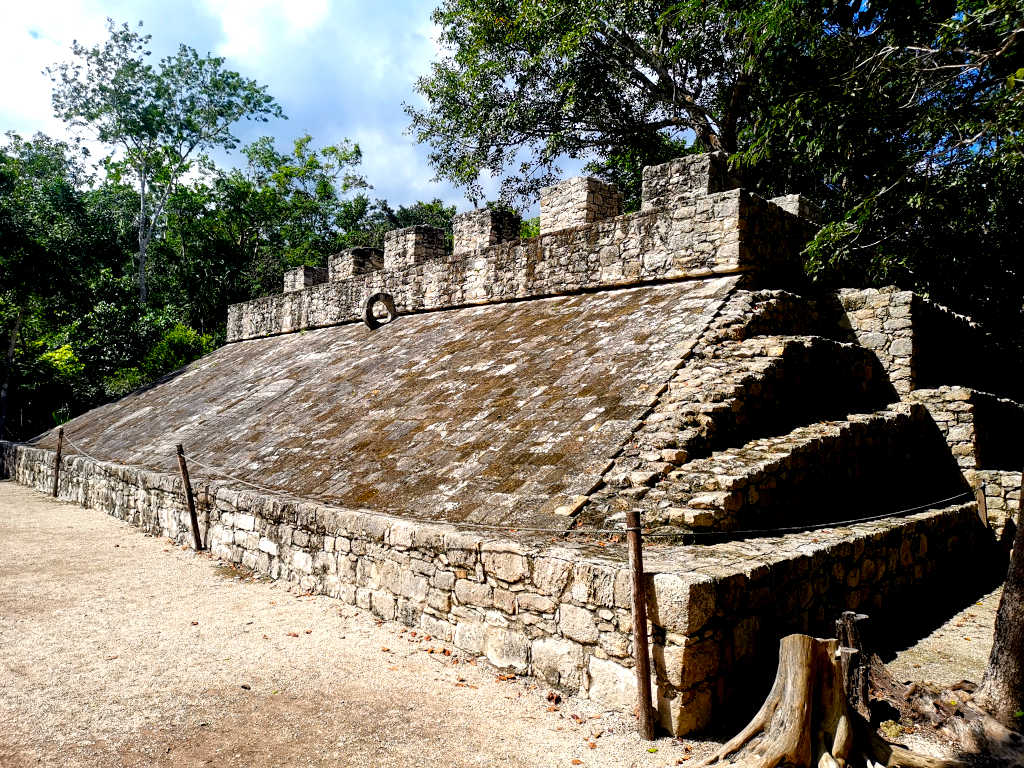


In the middle of the court on the ground, you will see two small little metal fences around some stones on the ground. One of the carvings is a skull and the other is an animal, although it is not clear what type. They are not the most amazing carvings but still quite interesting.
After the ball court, the next ruin is the Xaibé Pyramid which is speculated to be an observatory.
Xaibé Pyramid ❎
The Xaibe Pyramid is named Xaibe because of the four roads that used to spread out from the pyramid and Xaibe is the Mayan word for crossroads.
I liked the pyramid as it has rounded sides which are not common in Mayan architecture. It is believed that the pyramid may have been an observatory and that the four tiers represented the seasons. However no evidence has been discovered of its use, so it is mainly speculation.
Tip ✌️
One tip is that you will only see the Xaibe Pyramid if you take the bike path. The walking path is shorter but does not go past the Xaibe Pyramid. So if you are walking I think it would be worth taking the longer path to see this pyramid.
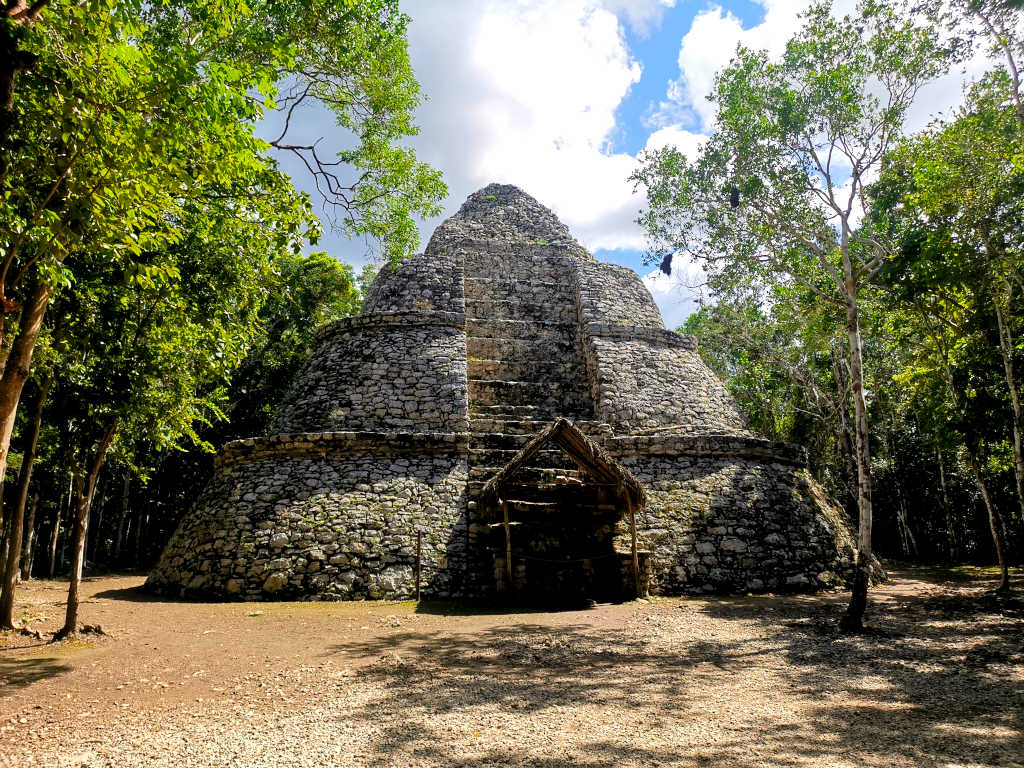
Nohoch Mul Pyramid ⛰️
After the Xaibe Pyramid, you will be making your way to the main attraction, the Nohoch Mul Pyramid. This pyramid is 42 m tall and one of the tallest constructed in the Mayan world. When I visited Coba for the first time in 2019 I was able to climb the pyramid. However, the decision was made to stop visitors from climbing so you will have to view it from the ground.
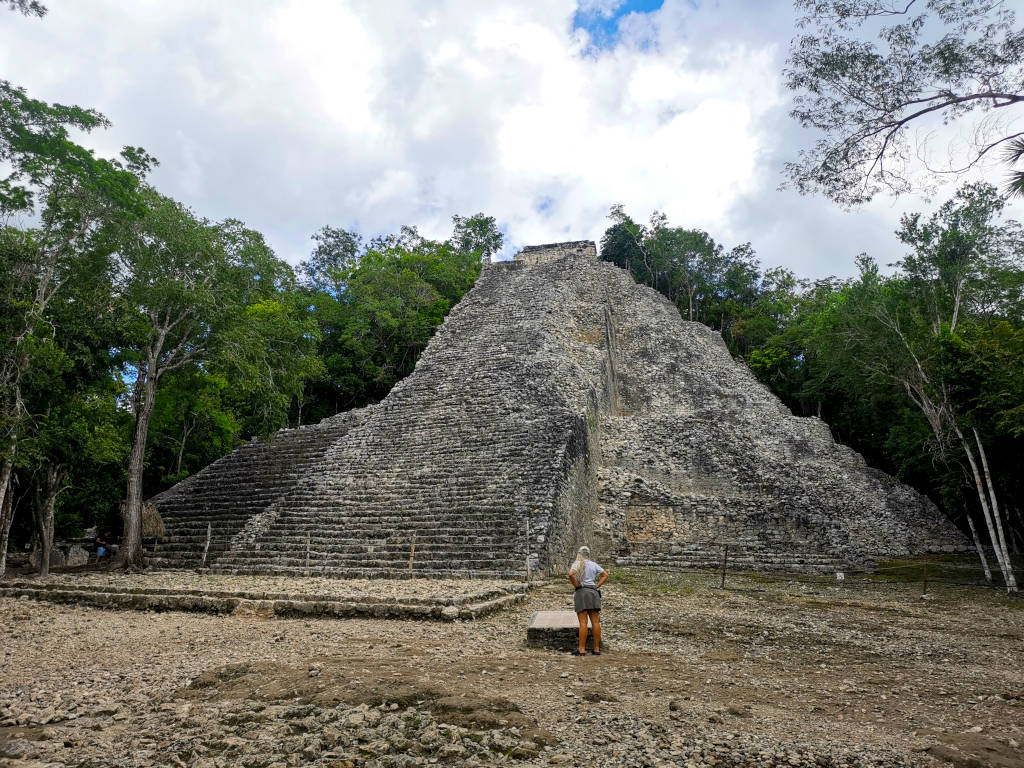
It is still a really impressive sight from the ground though and well worth the trip. One thing that I really like about the Nohoch Mul pyramid is that has been left mainly in the state it was found. The back side of the pyramid is almost totally covered in trees and the front is crumbling away quite a bit.
Other sites around the Yucatan are heavily restored and I prefer it when they have been left more in their natural state. The Nohoch Mul Pyramid really shows you how quickly nature takes over which I think is cool to see.
Apart from the main pyramid, there is also another carved stelae to have a look at before you go up the slope to the pyramid. The Nonoch Mul Pyramid is the last site to see and from here you can make your way back to the entrance.

Where To Eat At Coba Ruins 🍽️
Just before the car park to Coba, there are a few restaurants where you can grab something to eat at. The only one that we have been to is El Crocodrilo, a restaurant that serves traditional Mexican food from the Yucatan. The food is good and affordable and they also have some vegan and vegetarian options so it is a good spot to refuel after exploring the ruins.
Crocodile spotting 🐊
The restaurant is called El Crocodilo (‘The Crocodile’) because of the crocodiles living in the lake in front of the restaurant which we were able to spot so give it a try!
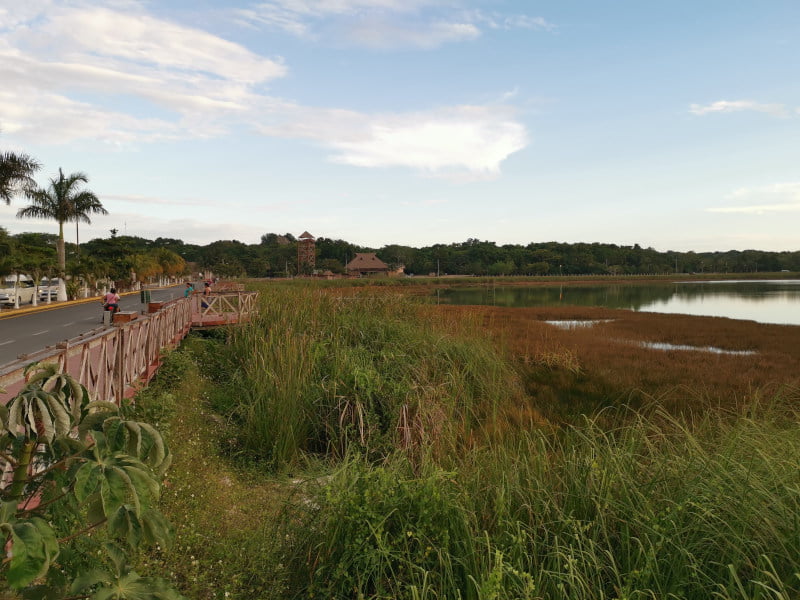
Part 2: Visiting the Coba Cenotes
If you have some free time after visiting the ruins there are some cool cenotes near Coba that you can visit. Read more about what cenotes are and the best tips for visiting them here.
At the Coba Ruins are three separate cenotes close by. These are Tankach-Ha, Choo-Ha and Multum-Ha. They are all about 6.5 kilometers away from the ruins and cost 100 pesos (5 USD) to enter each.
How To Get To The Coba Cenotes 📍
To get to the cenotes you can either drive, take a taxi or ride a bike. Two of the cenotes Tankach-Ha and Choo-Ha are located on the same road. Whereas Multum-Ha is located on a road by itself. You can walk between Tankach-Ha and Choo-Ha however you will need a car to go across to Mulutm-Ha. You can see all the locations on the map below.
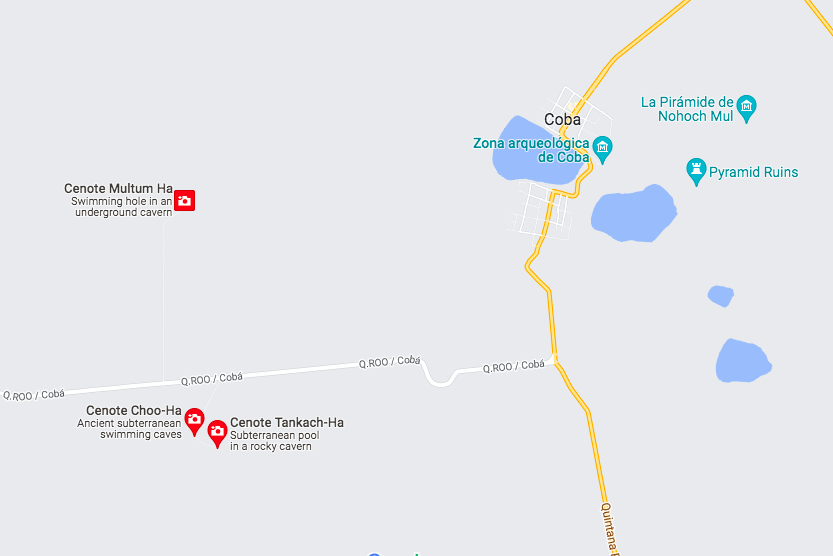
If you have plenty of time you should visit all three. But we didn’t have much time after visiting the ruins so we just visited Tankach-Cha because it has a 5 m and 10 m diving platform. Which was heaps of fun!
By Bike 🚲
I found out you can rent bikes from the entrance to the Coba car park. However, on the Saturday we went the guy who rents them was on his day off. So I am not sure how much they would cost to rent. But if you are really keen on biking you can ask if they have any available. You are not allowed to use the rental bikes of the Coba Ruins.
Just be warned that it is a 6.5 km ride and it will most likely be really hot. So only take a bike if you are in for a decent bike ride in the heat.
By Taxi 🚖
We got a taxi which cost us 500 pesos (25 USD). The driver took us to the cenotes and waited for about 1.5 hours at the cenote then took us back. So we felt 500 was a fairly decent price especially as it was shared between four people and we had limited time. But I am sure that if you haggle you could get the price down.
Cenote Tankach-Ha 🥽
We chose to visit Cenote Tankach-Ha because of the diving platforms which are a lot of fun. It is not the prettiest cenote but it is still very impressive once you enter. It is a huge circular underground cave that is essentially like a giant swimming pool with crystal clear water.
Because of how high the ceiling is they have been able to build the diving platforms. The 10 m platform is a lot of fun and sure to get your adrenaline pumping. But the 5 m platform is also a good option for those who are a bit scared of heights (as Katharina is ;)).
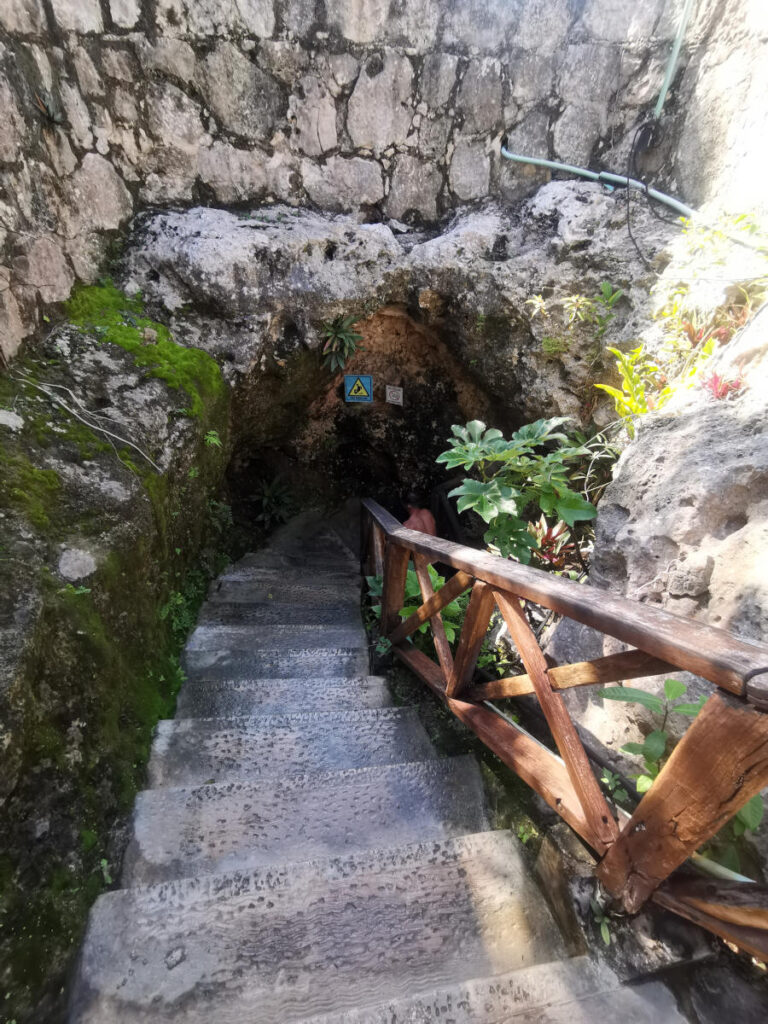
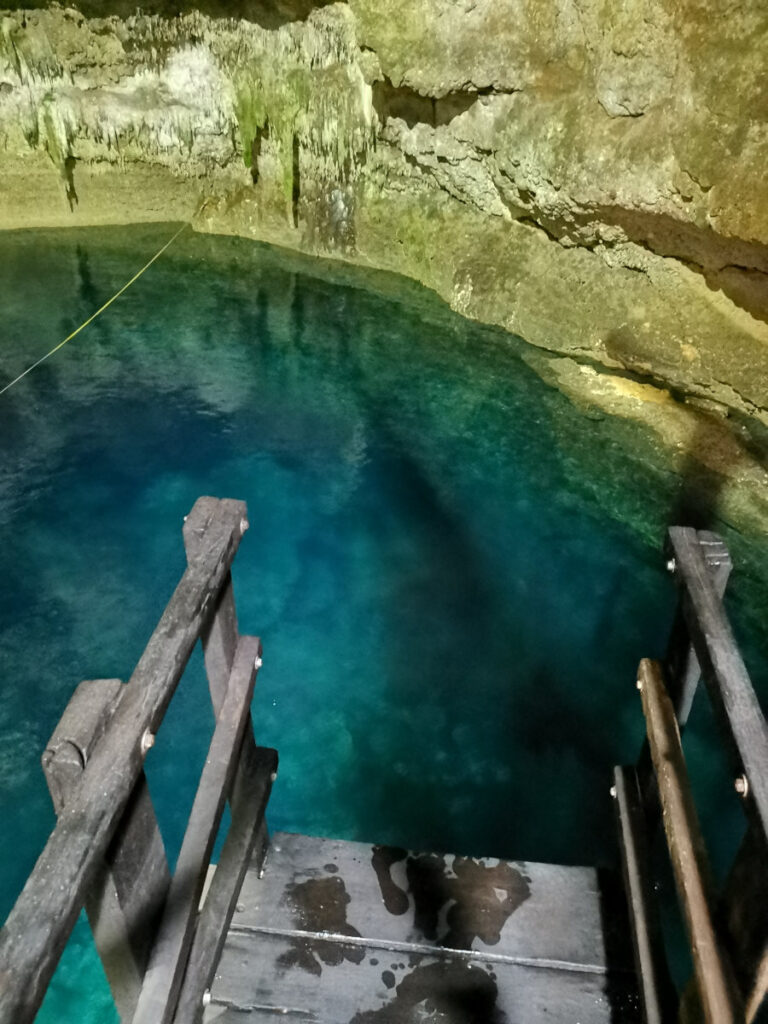
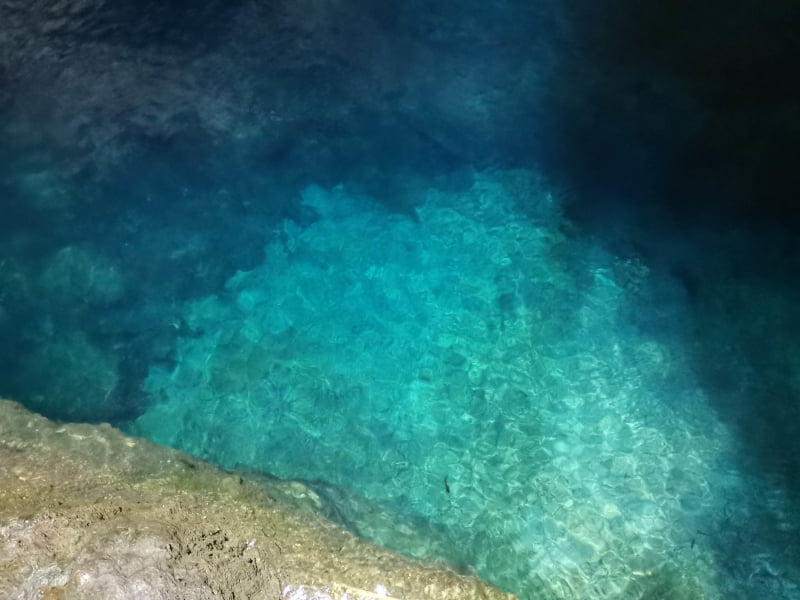
Aside from the platforms, it is still a good idea to bring a mask or goggles to go for a swim in the cenote. The water is crystal clear and there are some interesting rock formations underwater. If you go for a swim around the edge of the cenote there are lots of rock ledges that you can sit on at the far side which was cool.
There are also a whole lot of bats that live inside the cave and you can see them flying around and hanging from the ceiling. Which will be a positive to some people and a negative to others. We like it a lot.
Cenote Choo-Ha 💦
Cenote Choo-Ha is on the same road as Tankach-Ha and they are within walking distance apart. So you could also visit them at the same time. You just have to pay for tickets for both at the entrance to the road the cenotes are on which are 100 pesos (5 USD) each.
Cenote Choo-Ha is similar to Tankach-Ha because it is completely underground. Access is by stairs that go deep underground. But the cave is much shallower with prettier rock formations. So if you feel like chilling out rather than jumping off big platforms then Choo-Ha might be the cenote for you.
Cenote Multum-Ha 🏊♀️
Cenote Multum-Ha is the final cenote that you can visit. You will definitely need a bit of time if you want to visit all three cenotes. But every cenote I have visited has been amazing in its own way. So I think they are all worth visiting.
Cenote Multum-Ha is once again an underground cave cenote with a large platform above the water. This one is great for swimming but according to some reviews, it can get very busy later in the day. So you may want to get there early to avoid the crowds.
Coba Tour
If you do not feel like organising a trip to Coba by yourself you can also book a tour. There is a Tulum and Coba Tour from Get Your Guide that has quite good reviews.
But I still recommend trying to visit by yourself because it gives you a lot more freedom to explore on your own!
Are The Coba Ruins Worth It?
In my opinion, they are definitely worth it. There are many ruins all over the Yucatan peninsula but Coba is not overrun with tourists yet. So it is well worth it if you would like to escape the crowds and visit a more authentic site.
That Brings Us To The End Of My Coba Ruins Guide
Visiting ruins and cenotes is my favorite thing to do in the Yucatan. If you would like to read about some more cool cenotes to visit in the Yucatan check out our Cenote Guide here and read all about Playa del Carmen here.
Hey there! Some of the links on this page are affiliate links. This means that if you choose to make a purchase we may get a small commission at no extra cost to you. These commissions help us to generate income and keep creating content for you. So we greatly appreciate your support! Thanks!
Hi, I am Allan, a travel, health and fitness fanatic from New Zealand. I'm a former lawyer who turned into a full-time nomad in 2020. For the last 4+ years I've been traveling the world. I'm always on a hunt for good food, activities on a budget and workouts on the go. I hope you find my tips helpful and get inspired to travel more!

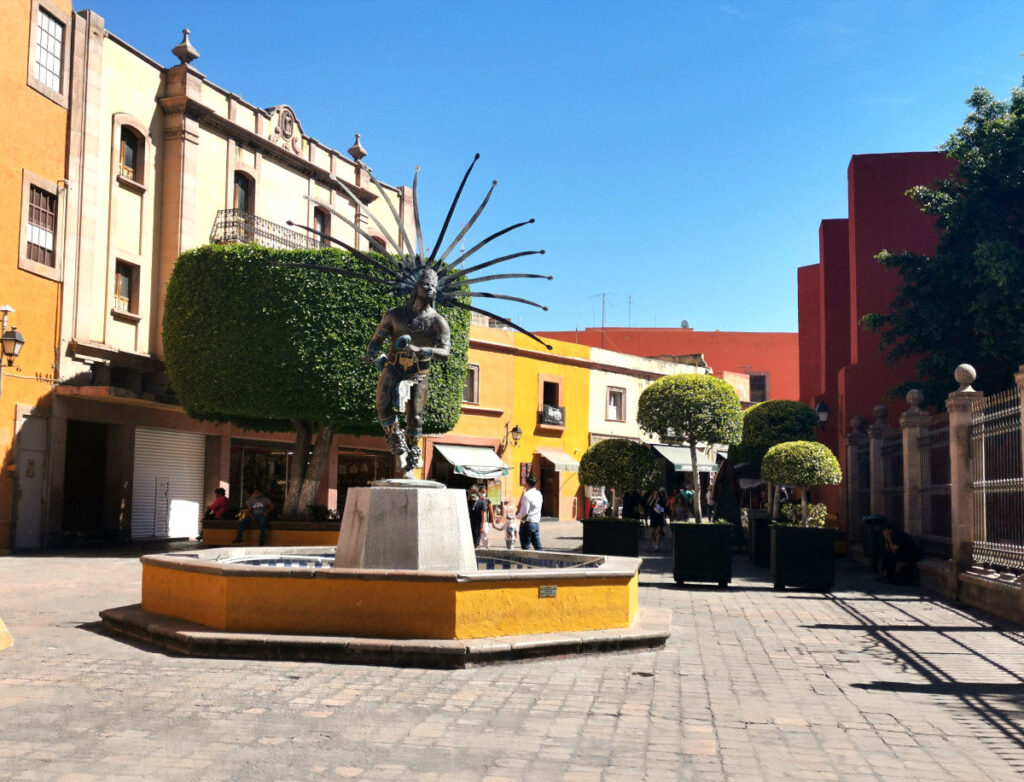
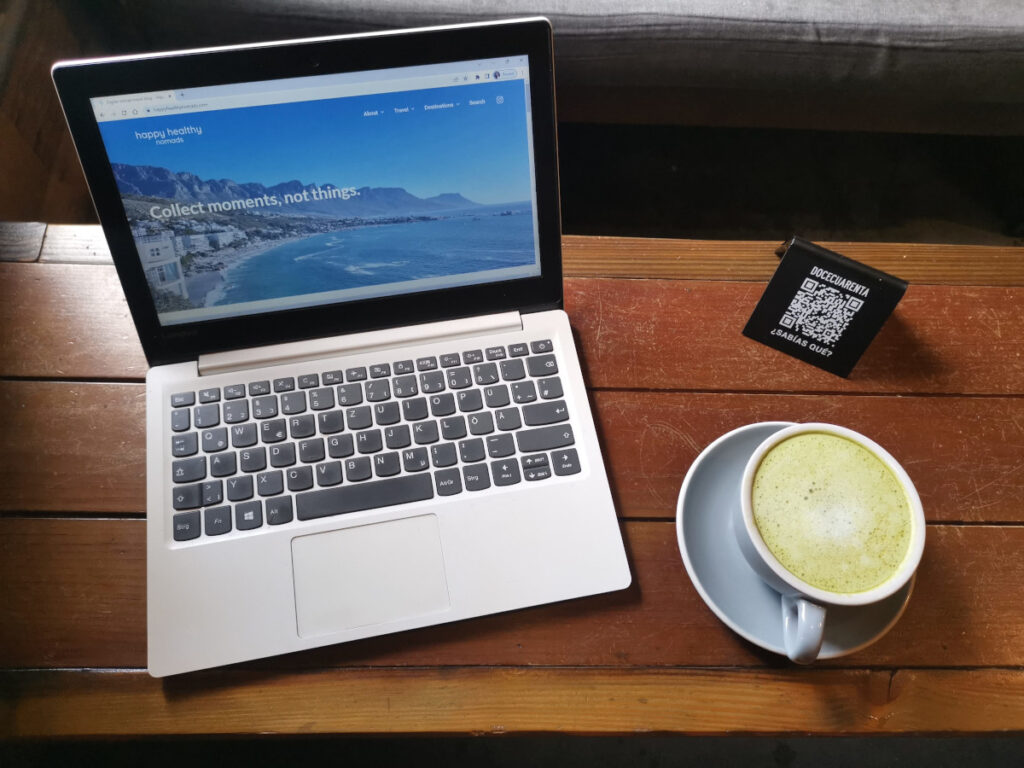

Hi Allan,
what a great and interesting article!!
It was very educational for me to learn about Mayan history and culture. I found your description of the ball game particularly impressive!
I am already looking forward to your next article!
Thanks Herbert! Yes I am really interested in the history of the Mayans so it was very easy for me to write it. I would like to write a guide for some more ruins soon.